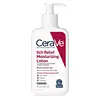What's inside
What's inside
 Key Ingredients
Key Ingredients

No key ingredients
 Benefits
Benefits

 Concerns
Concerns

 Ingredients Side-by-side
Ingredients Side-by-side

Pramoxine Hydrochloride 1%
Water
Skin ConditioningIsopropyl Myristate
EmollientPEG-100 Stearate
Glyceryl Stearate
EmollientCetearyl Alcohol
EmollientCetyl Alcohol
EmollientGlycerin
HumectantNiacinamide
SmoothingDimethicone
EmollientStearic Acid
CleansingAllantoin
Skin ConditioningPotassium Phosphate
BufferingCeramide NP
Skin ConditioningCeramide AP
Skin ConditioningCeramide EOP
Skin ConditioningCarbomer
Emulsion StabilisingZinc Citrate
Behentrimonium Methosulfate
Sodium Hydroxide
BufferingSodium Lauroyl Lactylate
EmulsifyingArginine PCA
HumectantMyristic Acid
CleansingSodium PCA
HumectantCholesterol
EmollientPalmitic Acid
EmollientTasmannia Lanceolata Fruit Extract
Skin ConditioningPhenoxyethanol
PreservativeDipotassium Phosphate
BufferingDisodium EDTA
Alcohol Denat.
AntimicrobialTocopheryl Acetate
AntioxidantHydrolyzed Hyaluronic Acid
HumectantXanthan Gum
EmulsifyingPhytosphingosine
Skin ConditioningPolyglyceryl-3 Diisostearate
EmulsifyingEthylhexylglycerin
Skin ConditioningPramoxine Hydrochloride 1%, Water, Isopropyl Myristate, PEG-100 Stearate, Glyceryl Stearate, Cetearyl Alcohol, Cetyl Alcohol, Glycerin, Niacinamide, Dimethicone, Stearic Acid, Allantoin, Potassium Phosphate, Ceramide NP, Ceramide AP, Ceramide EOP, Carbomer, Zinc Citrate, Behentrimonium Methosulfate, Sodium Hydroxide, Sodium Lauroyl Lactylate, Arginine PCA, Myristic Acid, Sodium PCA, Cholesterol, Palmitic Acid, Tasmannia Lanceolata Fruit Extract, Phenoxyethanol, Dipotassium Phosphate, Disodium EDTA, Alcohol Denat., Tocopheryl Acetate, Hydrolyzed Hyaluronic Acid, Xanthan Gum, Phytosphingosine, Polyglyceryl-3 Diisostearate, Ethylhexylglycerin
Water
Skin ConditioningGlycerin
HumectantCetyl Palmitate
EmollientParaffinum Liquidum
EmollientCaprylic/Capric Triglyceride
MaskingOctyldodecanol
EmollientCetyl Alcohol
EmollientGlyceryl Stearate
EmollientColloidal Oatmeal
AbsorbentDimethicone
EmollientMethylpropanediol
SolventPEG-40 Stearate
Emulsifying1,2-Hexanediol
Skin ConditioningPhenoxyethanol
PreservativePiroctone Olamine
PreservativeCarbomer
Emulsion StabilisingBenzyl Alcohol
PerfumingPolyglyceryl-2 Caprate
EmulsifyingDecylene Glycol
Skin ConditioningWater, Glycerin, Cetyl Palmitate, Paraffinum Liquidum, Caprylic/Capric Triglyceride, Octyldodecanol, Cetyl Alcohol, Glyceryl Stearate, Colloidal Oatmeal, Dimethicone, Methylpropanediol, PEG-40 Stearate, 1,2-Hexanediol, Phenoxyethanol, Piroctone Olamine, Carbomer, Benzyl Alcohol, Polyglyceryl-2 Caprate, Decylene Glycol
 Reviews
Reviews

Ingredients Explained
These ingredients are found in both products.
Ingredients higher up in an ingredient list are typically present in a larger amount.
Carbomer is a polymer of acrylic acid. Its main role is to create a gel consistency.
A high amount of carbomer can cause pilling or balling up of products. Don't worry, most products contain 1% or less of carbomer.
Cetyl Alcohol is a fatty alcohol. Fatty Alcohols are most often used as an emollient or to thicken a product.
Its main roles are:
Though it has "alcohol" in the name, it is not related to denatured alcohol or ethyl alcohol.
The FDA allows products labeled "alcohol-free" to have fatty alcohols.
Learn more about Cetyl AlcoholDimethicone is a type of synthetic silicone created from natural materials such as quartz.
What it does:
Dimethicone comes in different viscosities:
Depending on the viscosity, dimethicone has different properties.
Ingredients lists don't always show which type is used, so we recommend reaching out to the brand if you have questions about the viscosity.
This ingredient is unlikely to cause irritation because it does not get absorbed into skin. However, people with silicone allergies should be careful about using this ingredient.
Note: Dimethicone may contribute to pilling. This is because it is not oil or water soluble, so pilling may occur when layered with products. When mixed with heavy oils in a formula, the outcome is also quite greasy.
Learn more about DimethiconeGlycerin is already naturally found in your skin. It helps moisturize and protect your skin.
A study from 2016 found glycerin to be more effective as a humectant than AHAs and hyaluronic acid.
As a humectant, it helps the skin stay hydrated by pulling moisture to your skin. The low molecular weight of glycerin allows it to pull moisture into the deeper layers of your skin.
Hydrated skin improves your skin barrier; Your skin barrier helps protect against irritants and bacteria.
Glycerin has also been found to have antimicrobial and antiviral properties. Due to these properties, glycerin is often used in wound and burn treatments.
In cosmetics, glycerin is usually derived from plants such as soybean or palm. However, it can also be sourced from animals, such as tallow or animal fat.
This ingredient is organic, colorless, odorless, and non-toxic.
Glycerin is the name for this ingredient in American English. British English uses Glycerol/Glycerine.
Learn more about GlycerinGlyceryl Stearate is a mix of glycerin and stearic acid.
It is used to stabilize the mixing of water and oil ingredients. By preventing these ingredients from separating, it can help elongate shelf life. It can also help thicken the product's texture.
As an emollient, it helps soften skin and supports barrier-replenishing ingredients.
In cosmetics, Glyceryl Stearate is often made from vegetable oils or synthetically produced.
This ingredient may not be fungal-acne safe
Fun fact: The human body also creates Glyceryl Stearate naturally.
Learn more about Glyceryl StearatePhenoxyethanol is a preservative that has germicide, antimicrobial, and aromatic properties. Studies show that phenoxyethanol can prevent microbial growth. By itself, it has a scent that is similar to that of a rose.
It's often used in formulations along with Caprylyl Glycol to preserve the shelf life of products.
Water. It's the most common cosmetic ingredient of all. You'll usually see it at the top of ingredient lists, meaning that it makes up the largest part of the product.
So why is it so popular? Water most often acts as a solvent - this means that it helps dissolve other ingredients into the formulation.
You'll also recognize water as that liquid we all need to stay alive. If you see this, drink a glass of water. Stay hydrated!
Learn more about Water